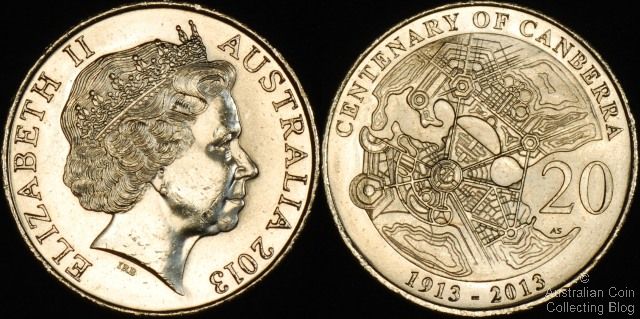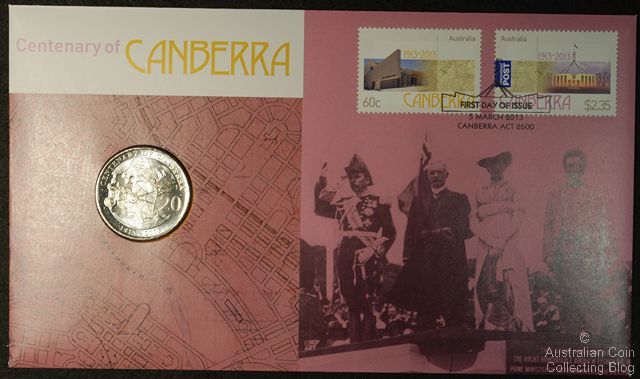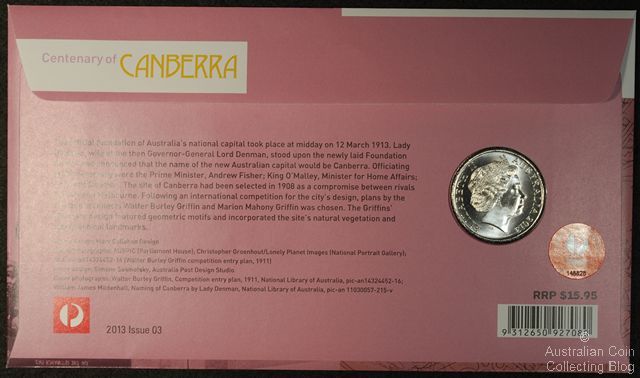
2013 Circulation 20 Cent Canberra Centenary
How many 20 cent coins do you have in your wallet or purse right now? Go on - have a look. Does your 20c coin show the 1913 blueprint of our nation's capital Canberra, designed by Walter Burley Griffin and his wife Marion? If it does, congratulations - you're the owner of one of the Royal Australian Mint's 5 million 20c coins released into circulation to celebrate Canberra's centenary. Yes, that's right - Canberra turned 100 on 12th March 2013 and throughout the entire year special events have been organized to showcase Canberra and it's role in our national history. This included "One Very Big Day" celebrations on a special public holiday March 11th where you could swap a 20c from your pocket for a new shiny Centenary of Canberra commemorative 20 cent at the RAM tent by Lake Burley Griffin.
But all's not lost if you've not yet seen the specially minted commemorative Centenary of Canberra 20c circulating coin, as Australia Post have released a PNC (philatelic numismatic cover) Stamp and Coin cover, incorporating the commemorative 20 cent coin and 2 commemorative stamps - a 60c stamp and an International $2.35 stamp, both designed by Melbourne-based Mary Callahan Design. Each stamp depicts Canberra's iconic streetscape blueprint and two of the capital's most prominent buildings - the 60c stamp portrays the National Portrait Gallery and the $2.35 stamp portrays Parliament House.
Imagine the celebrations on Capital Hill in Canberra on 12th March 1913 and how different it was compared to our celebrations of today. The official "naming of Canberra" ceremony photograph (gracing the PNC Stamp and Coin cover envelope) shows just how auspicious an occasion it was - there's Lady and Lord Denman, the Governor-General of Australia; the Prime Minister Andrew Fisher; and King O'Malley, the Minister for Home Affairs - with the official party standing atop of the newly laid foundation stones. It was a major event with plenty pomp and ceremony, a guard of honour for the official party, a 19-gun salute, 500 invited guests (mostly brought to Canberra from Sydney on specially chartered trains) and crowds of onlookers.
Lady Denman had the privilege of naming Canberra, which means 'meeting place' and chosen from the language of the Indigenous Australian inhabitants of the region, the Ngunnawal people. The decision to use the name Canberra resulted from over 700 public entries. Other suggestions included 'Sydmelperadbrisho', 'Cookaburra', 'Wheatwoolgold', 'Kangaremu', 'Democratia', 'Empire City', and even 'Swindleville'.
The location of where to site Canberra was fiercely contested between Victoria and NSW. A provision was even inserted into the Australian Constitution instructing the federal Parliament to select a NSW site, at least 160 km's from Sydney.
After relocating from Melbourne, The National Portrait Gallery building (as it's now called) became the home of the Commonwealth Parliament from 1927 to 1988. The building is located at the base of Capital Hill, where the official "naming of Canberra" ceremony took place in 1913 and is at the centre of the Walter Burley Griffin Canberra streetscape blueprint. The Provisional Parliament House (now referred to as the Old Parliament House) was only intended to be used as a temporary home until a more permanent building could be constructed. It is featured on the 1927 Parliament florin, our pre-decimal equivalent to the 20 cent piece.
New Parliament House didn't become a reality until the late 1980's with the building of the current Parliament House designed by Mitchell/Giurgola and Thorp Architects, and selected from the 329 entries of an international competition. The building took 7 years to complete, with 10,000 people working on the site and built primarily with Australian materials. It's one of the largest buildings in the southern hemisphere and was officially opened by Queen Elizabeth II on 9th May 1988 (and the theme of another commemorative 20c released in 2013, the 25th Anniversary of Parliament House).
The 20 cent coin in the Australia Post Centenary of Canberra PNC Stamp and Coin cover has a reverse design of depicting the iconic streetscape and blueprint of Canberra -a collaboration design between Aleksandra Stokic and the Centenary of Canberra team; with the obverse portrait of Queen Elizabeth II by Ian Rank-Broadley.
The PNC Stamp and Coin Cover was issued at $15.95. This PNC is the only way to purchase this commemorative coin in uncirculated condition.


2013 Canberra Centenary 20 cent PNC
Posted by harrisk at November 1, 2013 1:33 PM
Subscribe to our Newsletter


